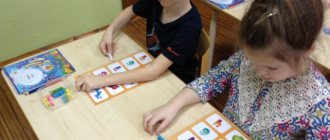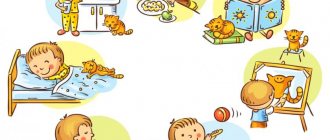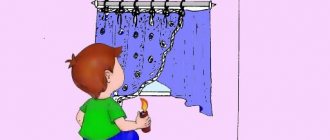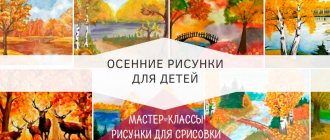Cards "EMOTIONS" card index on the topic
Emotions in pictures:
It is very important for understanding life to be able to understand the feelings and emotions of other people. It was for this purpose that cards were created and various emotions were depicted on them in pictures for children.
So, what are emotions in pictures?
Each card depicts a person's emotions in pictures. It can be anger, sadness, disgust, resentment, boredom, fear, shame, surprise, admiration, joy, interest, pleasure.
Each card consists of two sides, one of which shows a picture, for example, of a smiling child. And on the other hand - a description of the depicted emotion.
Using such cards, you can start studying with a child who is already six months old. Just show your baby a large picture and name the emotion depicted on it.
With children, starting from the age of two, you can simply limit yourself to reading the emotions on the cards. Or you can organize classes in the form of a game. For example, we conduct a conversation-discussion about what emotions exist and how to identify them. And then we come up with a whole situation that happened to the pictured baby. With the same success, you can recall fairy tales or stories in which the characters experience the same emotion for a certain emotion.
For older children who are already four years old, you can use cut-out picture cards depicting emotions. It's something like a puzzle. Each face consists of three parts, differing in size. The child’s task is to connect them correctly with each other and get a certain facial expression. But this is not so easy to do! After all, each face is characterized by certain curves of the eyebrows, lips, and nose shape. And after the child successfully copes with the task assigned to him, you can discuss this or that emotion.
For children five to six years old, you can already use cards with a schematic depiction of emotions, in which the child selects pictograms for each emotion shown in this picture. They also use cards with empty circles, in each of which you can draw your face with different emotions. For example, in one circle there is a happy face, in the other there is a sad face.
Such cards are used in classes with children in kindergartens, as well as in early development centers.
LiveInternetLiveInternet
Quote from Mamin_dnevnik message
Read in full In your quotation book or community!
Cards for activities with children - Emotions
Teach children to recognize emotions (joy, sadness, fear, anger) by facial expressions and intonation; depict these emotions using gestures, movements, and voice. Contribute to the enrichment of the emotional sphere Card index of games for the development of the emotional-volitional sphere in children 5-6 years old. “LET'S SAY HELLO” (from 5 years old) Purpose: the exercise continues acquaintance, creates a psychologically relaxed atmosphere. At the beginning of the exercise, we talk about different ways of greeting, real and comic. Children are invited to greet with their shoulder, back, hand, nose, cheek, come up with their own unusual way of greeting for today's lesson and say hello to them. (For each subsequent lesson, a new, previously unused way of greeting is invented! “STAND UP, ALL THOSE WHO ..." (from 5 years old) Purpose: the exercise is aimed at developing attention, observation, as well as continuing group acquaintance. The leader gives the task: “Stand up, everyone those who... - like to run, - enjoy good weather, - have a younger sister, - like to give flowers, etc. If desired, children can play the role of leader. After completing the exercise, children are asked questions summing up the game: - Now we’ll see , who in our group turned out to be the most attentive. Which of the guys remembered who in our group likes sweets? Who has a younger sister? Etc. Then the questions become more complicated (include two variables): - Who is in our group? group likes sweets and has a younger sister? Each question is addressed to a specific child, if he cannot answer himself, the group helps him" ————————————————————————— —————————————- No. 17 “DESCRIBE A FRIEND” (from 5 years old) Goal: development of attentiveness and the ability to describe what you saw, continuation of acquaintance. The exercise is performed in pairs (by all participants at the same time). Children stand with their backs to each other and take turns describing the hairstyle, clothes and face of their partner. Then the description is compared with the original and a conclusion is drawn about how accurate the child was. ——————————————————————————————————————— No. 18 “WHAT HAS CHANGED” (from 5 years old) Goal: development of attention and observation necessary for effective communication. Each child takes turns becoming a driver. The driver leaves the room. During this time, the group makes several changes in the children’s clothing and hairstyle; you can move to another place (but no more than two or three changes; all changes made must be visible). The driver’s task is to correctly notice the changes that have occurred. ________________________________________________________________________ No. 19 “HOW DO YOU FEEL?” (from 5 years old) Goal: development of attentiveness, empathy, the ability to feel the mood of another. The exercise is performed in a circle. Each child carefully looks at his neighbor on the left and tries to guess how he feels and talks about it. The child, whose condition is described, listens and then agrees with what was said or disagrees, complements. ——————————————————————————————————————— No. 20 “MY MOOD” (from 5 years old) Goal: developing the ability to describe one’s mood, recognize the moods of others, and develop empathy. Children are invited to tell others about their mood: you can draw it, you can compare it with some color, animal, state, you can show it in motion - it all depends on the child’s imagination and desire. ——————————————————————————————————————— No. 21 “A GIFT FOR EVERYONE (FLOWER - SEVEN-FLOWER) "(from 5 years old) Goal: development of a sense of team, the ability to make friends, make the right choice, cooperate with peers. The children are given the task: “If you were a wizard and could work miracles, what would you give to all of us now?” Or: “If we had a seven-flowered flower, what wish would you make?” Each child makes one wish by tearing one petal from a common flower. Fly, fly, petal, through the west to the east, through the north, through the south, come back, having made a circle, as soon as you touch the ground, be it in my opinion. Order that... At the end, you can hold a competition for the best wish for everyone. ——————————————————————————————————————— No. 22 “PORTRAIT OF THE BEST FRIEND” (from 5 years) Goal: development of analysis and self-analysis. Children are given the task of drawing a portrait of their best friend. Then a conversation is held: - Who do you consider your best, best friend? What qualities does this person have? Do you want to be considered a good friend? What should you do for this, how should you behave? During the general discussion, rules for joyful communication are formulated, which are drawn in a schematic form accessible to children or written down on a piece of Whatman paper in block letters (if the children already know how to read). For example: - Help your friends. - Share with them, learn to play and study together. - Stop your friend if he is doing something bad. Tell him if he's wrong about something. - Don’t quarrel, don’t argue over trifles; play together with everyone. - Do not envy. - If you did something bad, don’t be afraid to admit it, apologize. — Calmly accept the advice and help of other guys. - Don't be happy when someone loses. If you can, help him. - If you lose, don’t take your anger out on others, maybe you’ll win next time. _____________________________________________________________________________ No. 23 “ETUDE ON DIFFERENT POSITIONS IN COMMUNICATION” (from 5 years old) Goal: to get a feel for different positions in communication. Children are given the task to split into pairs. Communication in pairs takes place in a dialogue mode. Interesting and relevant topics for children are offered for communication: “My favorite animal”, “My happiest day last month”, etc. First, the communication situation is organized when both children sit facing each other, then one child sits on a chair, and the other stands near his chair (the children change places), then the children, sitting on the chair with their backs to each other, continue the conversation. Afterwards, the children are asked about the impressions and mood that arose during the communication process. How did you like to communicate? Why? ———————————————————————————————————————- No. 24 “HANDS ARE ACQUAINTING. HANDS ARE FIGHTING. HANDS MAKE PEACE” (from 5 years old) Goal: correlation of a person and his tactile image, removal of bodily barriers; developing the ability to express one’s feelings and understand the feelings of another through touch. The exercise is performed in pairs with eyes closed, children sit opposite each other at arm's length. An adult gives tasks (each task takes 2-3 minutes): - Close your eyes, stretch out your hands towards each other, introduce yourself with one hand. Try to get to know your neighbor better. Put your hands down” - Stretch your hands forward again, find your neighbor’s hands. Your hands are fighting. Put your hands down. - Your hands are looking for each other again. They want to make peace. Your hands make peace, they ask for forgiveness, you part as friends. Discuss how the exercise went, what feelings arose during the exercise, what did you like more? ——————————————————————————————————————— No. 25 “MAGIC TOOLS OF UNDERSTANDING” (from 5 years ) Introductory conversation. Goal: awareness that it is possible to help a person who is sad or ill, that everyone has the power to help everyone who needs it, understanding what exactly can be done for this. - What helps you when it’s difficult, bad, when you’ve done something wrong, when you’ve been offended? — What special things can people do with whom we enjoy communicating, what distinguishes them? (smile, ability to listen, eye contact, kind gentle voice, soft unsharp gestures, pleasant touches, polite words, ability to understand a person). — Why can we call these means of understanding “magical”? - Can you and I use these “magic” remedies when? ———————————————————————————————————————- No. 26 “FACES” (from 5 years old) Goal : Helps develop understanding of facial expressions and facial expressions. The leader hangs various pictures and masks on the board: - joy, - surprise, - interest, - anger, anger, - fear, - shame, - contempt, - disgust. The children’s task is to determine what feeling the mask expresses. ___________________________________________________________________________ No. 27 “MASKS” (from 5 years old) Goal: the ability to distinguish facial expressions, independently consciously use facial expressions to express your emotions. Each of the participants is given a task - to express grief, joy, pain, fear, surprise with the help of facial expressions... The remaining participants must determine what the participant was trying to portray. ______________________________________________________________________________ No. 28 “ROLE PLAYING SITUATIONS” (from 5 years old) Purpose: the exercise is performed in pairs, it is aimed at specific study, the use of “magic” means of understanding, the development of empathy, the use of already familiar means of understanding. Using the “magic” means of understanding, children must help: 1) a crying child who has lost his ball; 2) mom came home from work, she was very tired; 3) a friend in class is sitting sad, his mother is sick; 4) your friend is crying, he received a bad grade; 5) the girl next door asked you to make an applique for her... It is necessary to select so many situations so that each child can complete the task. ———————————————————————————————————————- No. 29 “DRAWING” (from 5 years old) Goal : development of empathy, creative imagination. The children are given the task: “Draw a kind animal and call it by an affectionate name, reward it with some magical means of understanding.” Drawing is carried out to the accompaniment of quiet, calm music, with paints or bright crayons, felt-tip pens on unlined white sheets. Then a competition is held for the kindest animal. The winner is awarded a certificate. ——————————————————————————————————————— No. 30 “ARTIST OF THE WORD” (from 5 years old) Goal : development of the ability to describe what is observed, the ability to highlight details essential for the description, the use of acceptable, non-offensive words, expansion of the active and passive vocabulary of children. Each child takes turns thinking of someone from the group and begins to draw his verbal portrait - his external characteristics (and, if possible, internal, psychological ones), without specifically naming this person’s name. Taking into account the level of development of children, you can offer them exercises on associative perception. (What animal does it look like? What flower? What piece of furniture? etc.) ————————————————————————————— —————————- No. 31 “LET’S MAKE A GIFT IN A CIRCLE FOR EACH OTHER” (from 5 years old) Goal: to develop in children a feeling for each other, an understanding of the other’s mood, the development of empathy. The presenter instructs everyone to give their neighbor on the right a gift, but not a specific gift, but a fictitious one: “What would you like to give to this particular person? Give the gift that you think he especially needs right now.” A gift can be described in words or shown with gestures. _________________________________________________________________________ No. 32 “TOY” (from 5 years old) Purpose: role-playing situations, practicing skills of effective interaction, empathy, and the ability to cooperate. The exercise is performed in pairs. One child from the couple is the owner of a beautiful and very beloved toy, which he loves to play with. Another child really wants to play with this toy. His task is to persuade the owner of the toy to let him play with it. Important: when performing this exercise, the child who owns the toy is given any toy that he should present as his favorite. As soon as the owner of the toy gives it to the asking child, the exercise is interrupted and the child is asked why he gave the toy.
Preview:
Emotions in pictures:
It is very important for understanding life to be able to understand the feelings and emotions of other people. It was for this purpose that cards were created and various emotions were depicted on them in pictures for children.
So, what are emotions in pictures?
Each card depicts a person's emotions in pictures. It can be anger, sadness, disgust, resentment, boredom, fear, shame, surprise, admiration, joy, interest, pleasure.
Each card consists of two sides, one of which shows a picture, for example, of a smiling child. And on the other hand - a description of the depicted emotion.
Using such cards, you can start studying with a child who is already six months old. Just show your baby a large picture and name the emotion depicted on it.
With children, starting from the age of two, you can simply limit yourself to reading the emotions on the cards. Or you can organize classes in the form of a game. For example, we conduct a conversation-discussion about what emotions exist and how to identify them. And then we come up with a whole situation that happened to the pictured baby. With the same success, you can recall fairy tales or stories in which the characters experience the same emotion for a certain emotion.
For older children who are already four years old, you can use cut-out picture cards depicting emotions. It's something like a puzzle. Each face consists of three parts, differing in size. The child’s task is to connect them correctly with each other and get a certain facial expression. But this is not so easy to do! After all, each face is characterized by certain curves of the eyebrows, lips, and nose shape. And after the child successfully copes with the task assigned to him, you can discuss this or that emotion.
PROGRESS OF THE CLASS
WARM-UP:
1) Creating a positive, working atmosphere in the group. 2) Preparing the child for the upcoming activity.
Greetings. Getting ready to work.
BREATHING EXERCISE
I.P.
- sitting. Children sit with their eyes closed. Exhale - open your eyes. Inhale - close your eyes. Continue, exhaling in the light, inhaling in the dark. Let your eyes relax completely when they are closed. Open your eyes and blink.
MAIN PART:
Diagnosis of the level of formation of emotions. Work on the topic (Thematic games and exercises).
Psychologist:
Today we will talk about emotions.
Look at this person’s face (The “Joy” icon is shown).
What kind of face do you think this person has? (Children's answers). Yes, joyful. How did you guess? (Children's answers). Yes, correct. Well done. When we have a joyful face, we smile widely, our eyes become narrow, they squint. Let's try to portray joy on our face.
(During this lesson, you can use the presentation “Emotions” from the “Presentations” section)
Exercise “PICTURE JOY”.
All participants sit in a circle. One player depicts “joy” and passes this expression on to the neighbor on the right, who must repeat what he saw on the neighbor’s face as accurately as possible.
Psychologist:
Let's play the game "SUNNY BUNNY" so that you are in a good mood.
Exercise “SUNNY BUNNY”.
o The sunbeam looked into your eyes. Close them. o He ran further over the face, gently stroke it with your palms on the forehead, on the nose, on the mouth, on the cheeks, on the chin o Gently stroke the head, neck, arms, legs. o He climbed onto his stomach - pet his belly. o The sunny bunny is not a mischief maker. He loves and caresses you, make friends with him. Great! We made friends with the sunbeam, take a deep breath and smile at each other.
Psychologist:
How did you feel after doing this exercise?
(Children's answers)
Physical education minute.
| Let's put our hands to the sides. We'll get the left one with the right one. | Stand with your feet apart, arms to the side. Turn to the left, clap your left palm with your right palm. |
| And then - on the contrary, there will be a right turn. | Turn to the right, clap your right palm with your left palm |
| One - clap, two - clap, Turn around one more time! | While clapping, turn around yourself. |
| One - two - three - four, Shoulders higher, arms wider! | Clap your hands, raise your shoulders, spread your arms to the sides. |
| We lower our hands down and squat down! | Slowly lower your arms down. To squat. |
Exercise “PICTOGRAM”
Psychologist:
(Shows the “Anger” pictogram)
Look at the face depicted on the card. How does the person in the picture feel? (Children's answers). Look at the expression on his face...What happened to his mouth? Eyebrows? What is the expression of the eyes? Now let’s listen to the story about the boy Petya, which is called “Angry Grandfather.”
Petya came to his grandfather’s village and immediately went for a walk. Grandfather was very angry because Petya left the gate without warning. Where did he go? What if something happens to him? Let's act out this story.
Exercise “I AM SAD WHEN...”
Each child tries to finish the sentence started by the leader... I feel sad when... FOR EXAMPLE:
the child describes sadness as the feeling when “... there are tears in your heart.”
o “I sometimes cry when I’m sad.” o “When you get really angry, it’s better not to hit anyone, because they might hit you back,” etc.
The psychologist demonstrates the “Fear” pictogram. Look at the picture. Who is depicted on it? What's his mood? (Discussion taking place).
Psychologist:
Let's play the game "Wolf and the Hares."
Game "WOLF AND HARES"
A leader is chosen from among the players - a wolf, the rest are hares. When the wolf falls asleep, the hares slowly go out for a walk, but when they hear footsteps, the wolf pounces on the hares and catches them. After the end of the game, a discussion takes place: what emotions do the players experience when they have played the role of hares. Were they scared?
Work in notebooks, fine art activities.
o Students should take turns choosing 3 colors of paint that they like best and draw 3 circles.
Oculomotor exercise
TARGET:
Relieve fatigue and eye strain, prevent eye diseases.
I.P.
- sitting. The head is fixed. The eyes look straight ahead. Begins practicing eye movements in 4 auxiliary directions (diagonally), bringing the eyes to the center. Movements are performed at a slow pace (from 3 to 7 seconds). Eye movements must be combined with breathing.
o Students are given sheets of paper. There are outlines of masks on them; you need to depict a happy, sad, scary mask.
Exercise “GUESS THE EMOTIONS”.
Students are offered pictograms depicting emotions. They must guess what emotion is depicted in a particular picture.
Exercise “FRIENDSHIP STARTS WITH A SMILE.”
Those standing in a circle join hands, look into the neighbor’s eyes and silently give him the kindest smile. (One at a time).
CONCLUSION:
- Checking completed tasks.
- Strengthening positive emotions from work.
- Summing up the lesson.
What children need to know about emotions
By the senior preschool age, the child has already formed an idea of human emotions, which include:
Children define and name psychological states, briefly describe them, and give examples of everyday situations in which a person experiences them.
Pictures for children depicting emotions teach the child to reason, describe cause-and-effect relationships, and analyze his own life experience.
During speech therapy work, it is useful to offer preschool children topics related to people’s experiences to compose narrative stories. For example:
Emotions can be divided into pairs with opposite meanings. For example: joy - sadness, disgust - admiration, boredom - interest, etc. Children should be able to recognize and name the feeling of the character in the picture, but also select antonyms for the definition. Exercises in this format allow you to more firmly consolidate the characteristics of emotions.
Children should know that we can learn about a person’s psychological state both from words and by observing actions and behavior. Each emotion has a corresponding dictionary and a set:
It is useful to have conversations with older preschoolers about how their emotional state needs to be managed, especially when it comes to negative feelings. You cannot give free rein to anger, irritation, or sadness. Express feelings only in socially acceptable ways. Children will be interested to know that in countries around the world people express feelings in different ways.
A set of cards for the development of the emotional sphere
A set of cards for the development of the emotional sphere
Explanatory note
Discipline:
classes with preschoolers on the development of the emotional sphere.
Age group:
children 5 – 7 years old.
Goals:
—
strengthening the ability to recognize emotions from schematic images and facial expressions;
- developing the ability to analyze emotions and understand what causes them and under the influence of which they change.
Type of lesson:
can be used in individual and group work.
Child knowledge and skills required for work:
preliminary work is required to study basic emotions and ways of expressing them.
Expected results:
- the child recognizes emotions from schematic images and facial expressions;
- understands what can cause certain emotions;
—
determines the emotional state of the hero based on the description of the situation.
Instructions for working with cards
The set of cards includes four sets. Set of cards No. 1
used in all three games below.
Sets of cards No. 2, No. 3, No. 4
can be supplemented by the teacher independently, changed in accordance with the children’s knowledge (studied emotions).
Game No. 1.
Stimulus material:
set of cards No. 1, set of cards No. 2.
Target:
consolidate the ability to recognize emotions from a schematic image and facial expressions; develop the ability to analyze emotions and understand what causes them.
Progress of the game.
Taking into account the child’s level of preparedness, he is offered either a schematic representation of emotions or facial expressions.
Option #1. The child is given a set of cards No. 1 (if the work is group work, then a set is issued for each child). The teacher shows cards from set No. 2 one by one. The child needs to pick up a card with an image of an emotion that will arise as a result of the situation depicted on the card.
Option #2. Pictures from set No. 1 are laid out on the table in front of the child (or children). The child is given cards from set No. 2. (If the work is group, then the cards from set No. 2 must be equally divided among the children). It is necessary to divide the pictures into groups (emotion – the situation that causes it).
Game No. 2.
Stimulus material:
set of cards No. 1, set of cards No. 3.
Target:
develop the ability to determine an emotional state from a description.
Progress of the game.
Taking into account the child’s level of preparedness, he is offered either a schematic representation of emotions or facial expressions.
The child is given a set of cards No. 1 (if the work is group work, then a set is issued for each child). The teacher reads a poem. Based on the description, the child(ren) must understand what emotion is being talked about and pick up the required card.
Game No. 3.
Stimulus material:
set of cards No. 4 (the child or teacher himself can compose a letter from set of cards No. 1).
Target:
develop the ability to analyze emotions and understand what causes them and under the influence of which they change; develop the ability to determine the emotional state from schematic images; develop imagination.
Progress of the game.
The game can be played individually or children can be divided into groups. “The postman brought you a letter (letters are handed to you). But it is unusual, and encrypted. Each letter schematically depicts several emotional states. They need to be deciphered, a short story about what happened was made.”
set of DOCX cards / 1.65 MB
For example, the letter shows a sad face, then a happy face. Example of a story. “It was raining lightly. Kolya sat by the window and was sad. But then the sun came out, the rain stopped, and Kolya happily ran outside.”
Defining emotions for children
For speech therapy work with students in the senior and preparatory groups of kindergarten, use the following list of emotional states:
Joy is a positive emotion familiar to everyone. We feel joy when something good happens. A person can express this feeling through words and actions. Signs of a joyful state are laughter and smiling. Experiencing joy feels good, as does bringing it to others. Sadness is a feeling that appears when we learn or think about something sad. Sadness cannot be called a strong emotion; it passes quickly. This does not mean that you should not allow yourself to be sad; sometimes every person needs it. But you shouldn’t indulge too much in a sad mood; it’s more useful to try to quickly get rid of it by doing something pleasant or useful. Anger is anger, strong irritation towards someone or something. Feeling angry is not pleasant, but sometimes it happens to everyone. It is a strong emotion that can cause trouble for us and others. It is important to explain to children how to manage anger and be able to express it correctly. If a person is often angry, then it is difficult for him to find friends, he is often lonely. Fear is a strong negative emotion that people experience if they are threatened by something. The danger can be real or expected or imaginary. Every child has repeatedly felt fear, so he can easily recognize its image in illustrations or photographs, and also give examples of events, objects and phenomena that cause this feeling in them. Children should know that fear varies in intensity, from fear to horror. It is important to explain to children that this emotion is necessary for a person, as it warns of danger. It can be added that the color black is often used to illustrate fear in pictures.
Didactic games for children 5-7 years old: Winter sports
Didactic games “Winter Sports” for children 5-7 years old
Author: Konshenko Marina Sergeevna, senior teacher of the Municipal Preschool Educational Institution “Kindergarten No. 153”, Saratov Description of the material: I offer you didactic games for children of senior preschool age on the topic “Winter Sports” .
Main goal: creating conditions for the formation of initial ideas about the Olympic Games and winter sports. This material will be useful for teachers of senior and preparatory groups and will help make not only the educational process more meaningful, but also leisure time. Didactic games to help older preschoolers familiarize themselves with winter sports
Goal: developing interest in physical education and sports. Objectives: • To form initial ideas about the Olympic Games and winter sports. • Develop cognitive activity and curiosity • Increase motivation for physical exercise.
In 2014, our country hosted a bright and large-scale event, the XXII Olympic Winter Games.
At the preschool educational institution we implemented the project “Together we will win!”, dedicated to these games. To make introducing children to the Olympic Games and winter sports more interesting and exciting, I made several educational games. Didactic games, compared to other types of games, have a characteristic feature: they are a source of knowledge in sports and physical education. Making such games in this age of ICT is not difficult. We download pictures, make up games, print them, and laminate them to make them last a long time. And now every year, when the “Winter Sports” themed week is implemented in January, educators use them in their work. In continuous educational activities, ideas about the Olympic Games and winter sports are formed. At the same time, children’s citizenship and patriotic feelings are formed. After all, such a large-scale event as the XXII Olympic Winter Games took place in our country in Sochi. This topic also allows you to develop interest in the events taking place in the country, cultivate a sense of pride in its achievements, and respect for your compatriots-athletes. Children, learning a lot of new and interesting things about the sports life of our country, the Olympic Games, athletes participating in the Olympics, come to the conclusion that physical education and sports are very interesting and beneficial for health. They have a desire to be like great athletes and to play sports. More often there is a desire to implement knowledge about the Olympic Games and winter sports in independent activities. Lotto “Equip an Athlete”. Goal: to teach children to select appropriate equipment and equipment for athletes. Lotto “Pictograms of Sochi 2014” Purpose: to teach children to name sports and select the appropriate pictograms.
Game "Pick up the pictogram". Goal: to consolidate children's knowledge about Olympic winter sports. It is necessary to select a pictogram for the corresponding sport and name it.
Game “Find the Fragment” Goal: developing the ability to compare objects, establish their similarities and differences. Children are given small picture fragments. You need to find which picture they belong to.
Game “Find a Pair” Goal: to teach children to select the same pictograms, made in a strict and laconic, monochrome palette, and the corresponding pictograms, made in the “patchwork quilt” palette.
Game “The picture has fallen apart” Goal: development of attention, memory, thinking, perseverance, fine motor skills. It is necessary to assemble the picture first according to the sample, then without. Images – winter sports, symbols of the Sochi 2014 Olympics. Game "Fold the track." Goal: developing the ability to compare and group by color, developing the color scheme (fixing the names of primary and secondary colors), the ability to distinguish color similarities and differences.
Game “Fourth Extra” Purpose: to learn to name and distinguish between winter and summer sports.
Card quiz Purpose: to consolidate children's knowledge about the Olympic Games and winter sports.
We recommend watching:
Story game for children 5-7 years old Intellectual game for children 6-7 years old. The child’s readiness for school Didactic manual on music for children of the preparatory group in preschool educational institutions Didactic games on ecology for children of the preparatory group of kindergarten
Similar articles:
Ball games for children 6 - 7 years old
Entertaining games for children 7-8 years old
Autumn games for children of the preparatory group in kindergarten
“Connect the dots” tasks for children 6-8 years old
Games for the development of logical thinking for children 6-7 years old in kindergarten
Drawn pictures
Emotions in pictures for children, used for classes on speech development, are presented in several versions: images of adults and children, people or fairy-tale characters. Printed pictures and drawings created by children are suitable for the development of speech in preschoolers.
Invite the children to draw themselves or another person experiencing a certain feeling. Drawing up a verbal explanation for such a picture is a speech therapy exercise that the children do willingly.
If children are not yet able to cope with independent depictions of emotional states, it is worth inviting them to create a collage from pre-prepared and printed facial details. Preschoolers aged 6-7 years are able to recreate emotions on paper on their own, but for younger children it is worth using ready-made templates and samples.
In speech therapy work, you can use not only drawing, but also coloring. Thematic coloring books are a useful and exciting material that is indispensable for girls and boys in kindergarten and at home.
It is important to first thoroughly study with children not only the names of different emotions, but also those artistic techniques that allow you to accurately convey one or another psychological state of a person. The use of pictograms can be very helpful in this regard.
Pictograms
Schematic representations of various emotions greatly help children in learning, remembering and recognizing human emotional states. Especially in the early stages of getting to know this topic. Various sets of “Emotions emoticons pictures for children” contain cards with a conventional image of anger, joy and other feelings.
Games with pictograms
Games with pictograms are a whole area in the work of speech therapists and psychologists. Schematic images of emotions (faces) are excellent material for stimulating a child’s speech activity. Here are some examples of using such images:
Pick and name
Prepare pictures of pictograms with different emotions and feelings for children. The task is to find out this or that state, give it a name, and then come up with a situation in which it would be appropriate. Children can use both their personal experience and remember the heroes of famous fairy tales and cartoons. It’s okay if at first the descriptions of emotions sound childish, gradually regular speech training will help these stories become more perfect.







